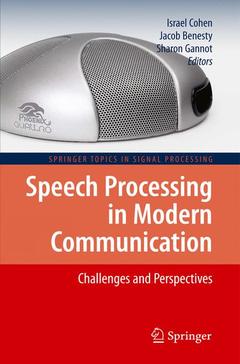Description
Speech Processing in Modern Communication, 2010
Challenges and Perspectives
Coll. Springer Topics in Signal Processing, Vol. 3
Coordinators: Cohen Israel, Benesty Jacob, Gannot Sharon
Language: French
Subjects for Speech Processing in Modern Communication:
Publication date: 05-2012
342 p. · 15.5x23.5 cm · Paperback
Publication date: 02-2010
342 p. · 15.5x23.5 cm · Hardback
Description
/li>Contents
/li>Comment
/li>
Modern communication devices, such as mobile phones, teleconferencing systems, VoIP, etc., are often used in noisy and reverberant environments. Therefore, signals picked up by the microphones from telecommunication devices contain not only the desired near-end speech signal, but also interferences such as the background noise, far-end echoes produced by the loudspeaker, and reverberations of the desired source. These interferences degrade the fidelity and intelligibility of the near-end speech in human-to-human telecommunications and decrease the performance of human-to-machine interfaces (i.e., automatic speech recognition systems).
The proposed book deals with the fundamental challenges of speech processing in modern communication, including speech enhancement, interference suppression, acoustic echo cancellation, relative transfer function identification, source localization, dereverberation, and beamforming in reverberant environments.
Enhancement of speech signals is necessary whenever the source signal is corrupted by noise. In highly non-stationary noise environments, noise transients, and interferences may be extremely annoying. Acoustic echo cancellation is used to eliminate the acoustic coupling between the loudspeaker and the microphone of a communication device. Identification of the relative transfer function between sensors in response to a desired speech signal enables to derive a reference noise signal for suppressing directional or coherent noise sources. Source localization, dereverberation, and beamforming in reverberant environments further enable to increase the intelligibility of the near-end speech signal.
These books may interest you

Speech Dereverberation 158.24 €



